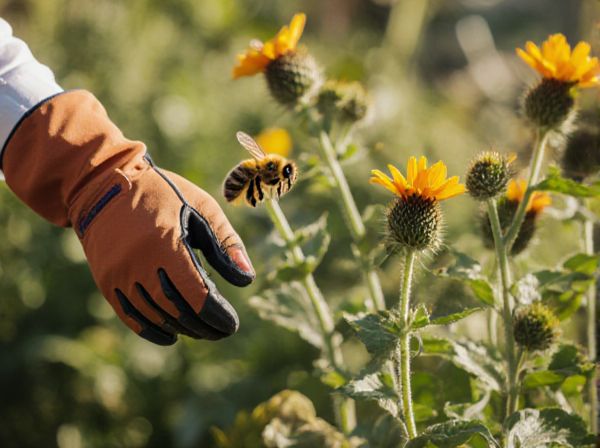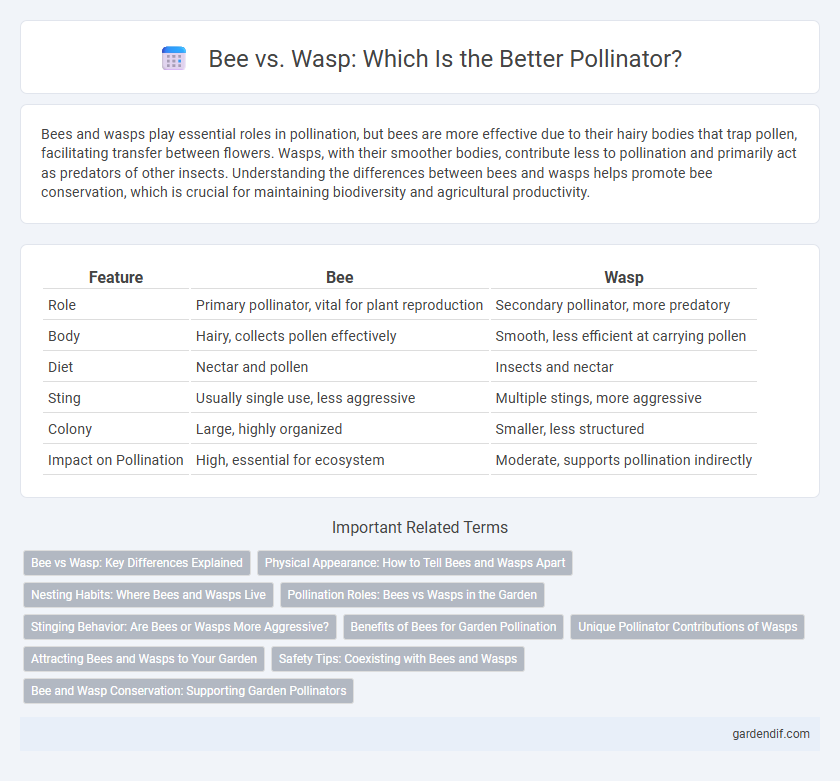
Bee vs Wasp Illustration
Bees and wasps play essential roles in pollination, but bees are more effective due to their hairy bodies that trap pollen, facilitating transfer between flowers. Wasps, with their smoother bodies, contribute less to pollination and primarily act as predators of other insects. Understanding the differences between bees and wasps helps promote bee conservation, which is crucial for maintaining biodiversity and agricultural productivity.
Table of Comparison
| Feature | Bee | Wasp |
|---|---|---|
| Role | Primary pollinator, vital for plant reproduction | Secondary pollinator, more predatory |
| Body | Hairy, collects pollen effectively | Smooth, less efficient at carrying pollen |
| Diet | Nectar and pollen | Insects and nectar |
| Sting | Usually single use, less aggressive | Multiple stings, more aggressive |
| Colony | Large, highly organized | Smaller, less structured |
| Impact on Pollination | High, essential for ecosystem | Moderate, supports pollination indirectly |
Bee vs Wasp: Key Differences Explained
Bees and wasps differ significantly in behavior, appearance, and ecological roles, with bees primarily being pollinators covered in branched hairs that facilitate pollen collection, while wasps have smooth bodies and are more predatory. Bees generally have a more robust, fuzzy body adapted for pollen transport, whereas wasps possess slender bodies with a distinct narrow waist and are known for hunting other insects. The ecological impact of bees centers on pollination crucial for agricultural ecosystems, contrasting with wasps that contribute to pest control but play a lesser role in pollination.
Physical Appearance: How to Tell Bees and Wasps Apart
Bees have hairy, robust bodies with flat hind legs adapted for pollen collection, while wasps exhibit smooth, slender bodies with narrow waists and long legs that hang down during flight. The coloration of bees is typically muted with shades of brown and yellow, contrasting with the bright yellow and black patterns often found on wasps. Unlike bees, whose hair traps pollen, wasps lack these hairy features, making their bodies appear more glossy and less fuzzy.
Nesting Habits: Where Bees and Wasps Live
Bees typically nest in hives, tree cavities, or underground burrows, favoring protected, stable environments for colony growth. Wasps, in contrast, build papery nests often in sheltered locations such as tree branches, eaves of buildings, or underground tunnels. Nesting habits influence their pollination roles, with bees' structured hives supporting large colonies, while wasps' transient nests accommodate smaller groups and more predatory behaviors.
Pollination Roles: Bees vs Wasps in the Garden
Bees are crucial pollinators, actively transferring pollen between flowers to facilitate plant reproduction and enhance garden biodiversity, while wasps primarily act as predators or scavengers with limited roles in pollination. Honeybees and bumblebees are especially effective due to their hairy bodies that trap pollen, contrasting with wasps' smoother exoskeletons that reduce pollen adherence. Gardens benefit more from bee activity, as their pollination supports fruit and vegetable yields, whereas wasps contribute by controlling pest populations but rarely assist in flower fertilization.
Stinging Behavior: Are Bees or Wasps More Aggressive?
Wasps exhibit more aggressive stinging behavior than bees, often attacking repeatedly without losing their stinger. Bees, particularly honeybees, sting defensively and lose their stinger after one sting, which limits their ability to sting multiple times. This difference in stinging mechanisms makes wasps generally more aggressive and dangerous during encounters.
Benefits of Bees for Garden Pollination
Bees play a crucial role in garden pollination by efficiently transferring pollen between flowers, which enhances fruit and seed production. Their fuzzy bodies are adapted to collect and distribute pollen more effectively than wasps, directly supporting plant reproduction and biodiversity. Unlike wasps, bees contribute to ecosystem health by boosting crop yields and maintaining floral diversity essential for garden vitality.
Unique Pollinator Contributions of Wasps
Wasps contribute uniquely to pollination by targeting plant species often overlooked by bees, including certain orchids and figs, ensuring diverse floral reproduction. Their ability to pollinate during cooler or cloudier conditions expands the pollination window beyond typical bee activity. Wasps also play a crucial role in maintaining ecological balance by controlling pest populations while facilitating pollination.
Attracting Bees and Wasps to Your Garden
Plants with brightly colored flowers and sweet nectar-rich blooms are highly effective in attracting bees, which are essential pollinators for many crops and wild plants. Wasps are drawn to protein sources such as insects and sugary substances but can also visit flowers, especially those with less nectar, contributing to pollination. Incorporating a variety of native flowering plants and providing water sources can create a balanced habitat that supports both bees and wasps, enhancing garden biodiversity and ecosystem health.
Safety Tips: Coexisting with Bees and Wasps
Bees and wasps play crucial roles in pollination but require different safety approaches when coexisting. To prevent stings, avoid sudden movements, wear light-colored clothing, and keep food covered outdoors, as wasps are attracted to sugary substances and proteins. Maintaining calm behavior and sealing potential nest sites around homes enhances safety while supporting these essential pollinators.
Bee and Wasp Conservation: Supporting Garden Pollinators
Bees and wasps play crucial roles in pollination, with bees being more efficient pollinators due to their body structure and behavior. Supporting garden pollinators involves planting diverse, native flowering plants that provide continuous nectar sources and creating habitats with dead wood or bare soil for nesting. Avoiding pesticides and promoting organic gardening practices significantly enhance bee and wasp conservation, ensuring healthier ecosystems and improved crop pollination.
Bee vs Wasp Infographic

 gardendif.com
gardendif.com